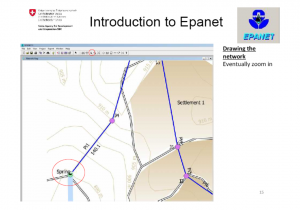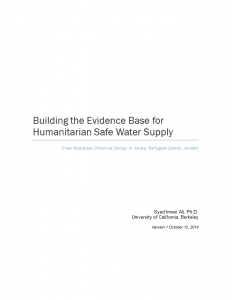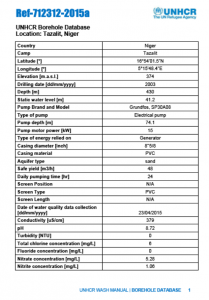
This 161 page document provides a thorough introduction to EPANET (US Environmental Protection Agency) water distribution network modelling software with a focus on designing networks for refugee settings.

This document contains guidelines to help WASH actors in refugee settings select household water treatment products. The document includes an overview of: • Categories of HWTS; • Health benefits; • When to use HWTS and existing decision tree; • Criteria regarding HWT to be considered by the field; • Mandatory components; • UNHCR Checklist for HWTS; • HWT concerns; • Household water treatment cards; • Safe water storage;• Further reading; • Acknowledgement

This brief is intended to highlight key elements of an effective response to an outbreak of hepatitis E virus (HEV) infection in refugee setting. It focuses on specific response actions, including the review of common risks associated with health, water, sanitation, and hygiene (WASH). The overall implementation of response actions and mode of operation should be context specific, as highlighted by the examples given from Dadaab (Ifo) Kenya and South Sudan.
Tags: Bulk Water Treatment, Excreta Management, Handwashing with Soap, Household Water Treatment, Hygiene Promotion, Public Health, Water Quality Testing and Surveillance, and Water Safety Plans. Locations: Africa, Dadaab, East and Horn of Africa, Kenya, South Sudan, and Sudan and Chad Special Operational Region. Languages: English. Organisations: UNHCR. Categories: WASH Emergency Guidelines, WASH Guidelines, WASH Operational Guidelines, WASH Policy Guidelines, and WASH Reference Documents.

The SMU team conducted five sampling missions to UNHCR refugee camps in Uganda, Kenya, Bangladesh, Djibouti, and Liberia. Overall, these missions were considered a success with 17 camps, 7 villages, and a few additional sites visited. The team collected 213 camp samples and 229 total samples for analyses in the laboratory. Camp conditions and source water characteristics varied widely amongst the five countries but also within the camps themselves.

This document looks at drinking water, sanitation and renewable energy solutions and options in three camps in Dolo Odo with recommendations and conclusions.

Current emergency safe water guidelines are based on little field evidence. We launched an observational study on chlorine decay in the Azraq refugee camp, Jordan in July-August 2014 in order to: i) develop evidence-based guidelines for centralized batch chlorination in humanitarian operations; and ii) identify factors affecting the safe water chain. This study builds on earlier work from South Sudan and adds to the evidence base that study initiated.

Close to half a million refugees live in Dadaab, Kenya and rely on groundwater from the Merti Aquifer. Preliminary hydrogeological mapping indicates over exploitation of the fresh water aquifer could result in salt water intrusion, which would put the security of water supply for the refugee camps and host population at risk. UNHCR together with University of Neuchâtel has embarked on a comprehensive study of the Merti Aquifer including remote monitoring, and numerical modelling of the aquifer in order to develop a sustainable groundwater management plan for the aquifer which supplies water to all the refugee camps in Dadaab, Kenya.

Water safety plan produced by CDC following a technical support visit to Dadaab in 2009. The report contains: An overview of Dadaab water supply system; Identification of hazards and risks; Control measures and prioritisation of risks; Sanitation and hygiene; and Conclusions.

This brief is intended to highlight key WASH elements for camps closure. It focuses on specific actions, including the highlights of public health risks associated with health, water, sanitation, and hygiene (WASH) when dealing with decommissioning of WASH infrastructures. The overall closure implementation actions and modus operandi should be context specific and properly planned in coordination with key stakeholders.
Tags: Camp Closure, Cross Cutting, Environment, Excreta Management, Solid Waste Management, WASH Coordination, WASH Programme Health and Safety, WASH Programme Management, WASH Strategy Development, and Water Supply. Languages: English. Organisations: UNHCR. Categories: WASH Guidelines, WASH Operational Guidelines, WASH Policy Guidelines, and WASH Reference Documents.

Tazalit Country Niger Camp Tazalit Latitude [°] 16°54’01.5″N Longitude [°] 5°15’48.4″E Elevation [m.a.s.l.] 374 Drilling date [dd/mm/yyyy] 2003 Depth [m] 430 Static water level [m] 41.2 Pump Brand and Model Grundfos, SP30A08 Type of pump Electrical pump Pump depth [m] 74.1 Pump motor power [kW] 15 Type of energy relied on Generator Casing diameter [inch] […]
Tags: Boreholes, Drilling, and Water Supply. Locations: Africa, Niger, and West Africa. Languages: English. Organisations: UNHCR. DatabaseDocTypes: Borehole Drilling Logs.
 English
English










